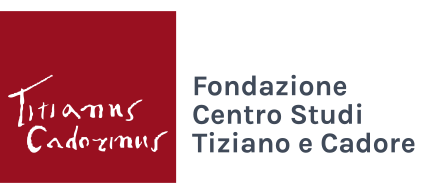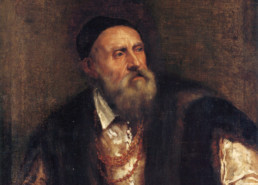Titian
1483/85-1488/90
Titian was born in Pieve di Cadore: the exact date, which lies between the years indicated, is not recorded and therefore remains a subject of debate.
1508-1509
He succeeded Giorgione in the decoration of the Fondaco dei Tedeschi near the Rialto Bridge in Venice, painting the frescoes of the ground-floor façade. The first mention of the project was given by Lodovico Dolce (1557), who remembers that Titian took over the project “even before he had turned twenty years of age”.
1511
Titian’s name appears in the account books of the Scuola del Santo in Padua for the execution of three frescoes depicting Miracoli di Sant’Antonio. He received full payment from the Scuola for the three scenes on 2 December.
1513
Through Pietro Bembo he was invited to go to Rome as a painter for the papal court, but he preferred to offer his services to the Serenissima, undertaking to paint a battle scene in the Grand Council Chamber of the Doge’s Palace in Venice (destroyed by fire in the 1577 fire, but recorded in a 1569 etching by Fontana). The painting, which was only completed in 1538, depicted the Battle of Cadore; a theme strongly wished-for by Doge Andrea Gritti. In May of the same year, Titian opened his atelier in San Samuele district of Venice. His assistants included Antonio Buxei and Ludovico di Giovanni.
1516
His relations with the court of Ferrara began after Giovanni Bellini’s death. He is recorded in Ferrara from the 31 January to 22 March. Germano Casale, guardian of the convent of the Santa Maria Gloriosa dei Frari in Venice, commissioned from him The Assumption of the Virgin, which was placed above the high altar of the church on 19 May 1518.
1517
He was given the “Sensarìa”, or percentage remuneration, from the Fondaco dei Tedeschi, which had previously been granted to Giovanni Bellini. This brought him a whole series of advantages, including exemption from tax, the yearly payment of 100 ducats and the acknowledgement of an additional 25 ducats for every official portrait of a doge to be placed in the Grand Council Chamber.
1520
He painted the Madonna and Child in Glory with Angels, Saints Francis adnd Blaise and a Donor (Pinacoteca Civica, Ancona) for Alvise Gozzi, a merchant from Ragusa. This is one of his first dated works. The altarpiece was inspired by the composition of Raphael’s 1512 Madonna di Foligno (Pinacoteca Vaticana, Vatican City).
1522
He completed the polyptych in Santi Nazaro e Celso in Brescia for the papal legate Altobello Averoldi.
1523
Relations with Federico II Gonzaga and the court of Mantua began. He painted an official portrait of Doge Andrea Gritti (now lost), who also commissioned the fresco depicting Saint Christopher, which was completed in just three days (Ducal Palace, Venice). He sent the “Baccanali” to Ferrara for Duke Alfonso d’Este.
1525
He married Cecilia from Perarolo di Cadore, with whom he had already been living for some time and with whom he had sired two sons, Pomponio and Orazio. His daughter Lavinia was born later, around 1530.
1526
On 8 December, the Pesaro altarpiece (I Frari, Venice), which had been commissioned from him some seven years earlier by Bishop Jacopo Pesaro, was placed above the altar of the Immaculate Conception. Titian had worked on the altarpiece from 1519, the year in which the first deposit was paid, until 1526, the date of the final payment, receiving altogether 102 ducats.
1530
On the 27 April, the altarpiece depicting The Death of St. Peter Martyr (destroyed by fire on 16 August 1867) was placed on the altar of the confraternity of Saint Peter Martyr in the church of Santi Giovanni e Paolo in Venice. He painted the first portrait of Charles V (now missing), on the occasion of his crowning in Bologna. At this time, a rare synergetic relationship was established between patron and artist. Titian’s wife Cecilia died on the 3 August.
1531
The votive painting of Doge Andrea Gritti was placed on display in the Doge’s Palace in Venice. In September, Titian left his atelier in San Samuele and moved to Biri, in the San Canciano contrada of Venice, where he lived until his death.
1533
During one of Charles V’s new stays in Bologna, he painted another portrait of the Emperor (Museo del Prado, Madrid), for which he was awarded the title of Palatine Count, a title that allowed the painter to create notaries and legitimize natural children.
1538
He completed the Battle of Cadore for the Doge’s Palace and the Presentation of the Virgin in the Temple (Gallerie dell’Accademia, Venice ) for the hall of the Albergo della Scuola della Carità. He completed the portraits of Francesco Maria Della Rovere and Eleonora Gonzaga and painted the Venus of Urbino for their son Guidobaldo (all in Galleria degli Uffizi, Florence).
1539
He painted the portrait of Doge Pietro Lando (destroyed), who succeeded Andrea Gritti.
1540
The portrait of Cardinal Pietro Bembo(National Gallery of Art, Washington) was painted during this year. Titian’s acquaintance and mutual esteem with the cardinal can be dated back to the turn of the century. The poetic components and amorous dialogues collected in Bembo’s Gli Asolani provide a key for the iconological interpretation of Titian’s early works.
1541
He delivered the Allocution of Alfonso d’Avalos, Del Vasto Marquee, governor of Milan (Museo del Prado, Madrid). From Charles V, he was granted a yearly pension of 100 ducats from a Milanese bank.
1543
In Busseto, he met and painted the portraits of Charles V and Paul III. He signed and dated the Ecce Homo (Kunsthistorisches Museum, Vienna) for the rich merchant Giovanni d’Anna.
1544
He completed the three paintings of biblical scenes (Cain and Abel, The Sacrifice of Isaac, and David and Goliath) for the ceiling of the church of Santo Spirito in Isola, today preserved in the sacristy of the Santa Maria della Salute in Venice.
1545
He painted the portrait of the academic Pietro Aretino (Galleria Palatina di Palazzo Pitti, Florence), who was a great friend and essential supporter of his. In September, he was in Pesaro and Urbino. In October, he moved to Rome where he worked for Paul III and the Farnese circle. He visited antiquities with Giorgio Vasari and Sebastiano del Piombo. The Danae (Museo di Capodimonte, Naples), painted for Cardinal Alessandro Farnese, was seen by Michelangelo, who, while praising the colour, criticized the “lack of art and draftsmanship”.
1548
He moved to Augsburg in Germany at the time of the Imperial Diet. He painted the portrait of Charles V on Horseback (Museo del Prado, Madrid) and that of Charles V Seated in an Armchair (Alte Pinakothek, Munich), as well as the posthumous portrait of Empress Isabella (Museo del Prado, Madrid), who died in 1539, and that of Charles and Isabella together (missing), known to us today through a copy by Rubens. He returned to Venice in October and in December painted the portrait of Prince Philip, Charles V’s son, in Milan. Such a vast production of portraits confirms Vasari’s statement: “there is almost no-one of great name, nor prince, nor gentle-woman, who has not been painted by Titian”.
1550-1551
Titian returned to Augsburg once again for a long period of time, during which he painted pictures of devotion, paintings of amorous subjects and portraits of imperial officers.
1552
He began the long correspondence with Philip, today preserved in the Royal Spanish archives of Simancas. Following the abdication of his father Charles V, Philip II assumed the crown of Spain (but not the Imperial crown). He was to become an eminent patron, commissioning a series of both religious and mythological works from Titian.
1554
He sent The Glory (Museo del Prado ,Madrid) to Charles V. This image of the triumph of the Most Holy Trinity was taken by Charles to the Yuste monastery after his abdication. For Philip, who had by now become his most favoured patron, Titian painted Danae and Venus and Adonis (both Museo del Prado, Madrid).
1555
He painted the portrait of Doge Francesco Venier (Thyssen-Bornemisza Museum, Madrid).
1559
He sent the “poesies” of Diana e Atteone and Diana e Callisto (jointly owned by the National Gallery, London and the National Galleries of Scotland, Edinburgh) and the Entombment (Museo del Prado, Madrid) to Philip II. He continued to work on the Martyrdom of Saint Lawrence for Lorenzo Massolo’s altar in the church of the Crucifers (I Gesuiti) in Venice. In the merchant Antonio della Veccia’s will, mention is made for the first time of the Annunication, which was later placed in the church of San Salvador, Venice. At the end of the year, his brother Francesco died. Francesco had for a long time overseen the administration of the financial interests of the family in Cadore, especially in relation to the wood trade.
1562
He sent Philip the Rape of Europa (Isabella Stewart Gardner Museum, Boston).
1565
Together with Marco Vecellio (his cousin Toma Tito’s son, who for Titian remained his trusted notary in Cadore), Emanuele Amberger and Valerio Zuccato, he went to Pieve di Cadore to formalize his solemn commitment to paint frescoes based on his designs for the choir of the Archidiaconal church; the project, which began in 1566, was completed the following year. In the same church, he painted the canvas which is still found above the family’s altar. It was later mentioned by Vasari, who had seen it in May 1566 when he visited the painter’s Venetian studio.
1566
Together with other Venetian artists (including Palladio), he was elected as a member of the Florentine Academy of the Arts (Accademia dei disegni), undoubtedly upon the recommendation of Vasari. From the Council of Ten in Venice he was granted the copyright to reproduce some of his works as prints, which were produced by the Flemish etcher Cornelis Cort.
1570
This year and the following years saw the creation of three of Titian’s late mythological masterpieces, which are characterized by an experimental language of “patches, thicknesses, vortexes, blurs and strokes” (Gentili 2012): The Bacchus and Ariadne, which is traditionally known as Nymph and Shepherd (Kunsthistorisches Museum, Vienna), the Flaying of Marsyas (Olomouc Episcopal Museum, Kroměříž), and the Death of Actaeon (National Gallery, London).
1571
He sent the Tarquin and Lucretia (Fitzwilliam Museum, Cambridge) to Philip II.
1574
He received a visit from Henry di Valois, who was travelling to France to be crowned King Henry III. In December he sent Antonio Perez, Philip II’s secretary, a long list of the paintings sent during the previous decades, asking for payment.
1575
He sent Philip II Saint Jerome destined for the San Lorenzo dell’Escorial monastery, where it is still kept. A document issued in March by the apostolic nuncio orders the friars of the Santa Maria Gloriosa dei Frari in Venice to return the Pietà to the painter, because it had been installed in a different place than the one agreed upon. Titian’s ultimate masterpiece, which was originally destined for his burial place, is now preserved in the Gallerie dell’Accademia in Venice.
1576
As the plague raged in Venice, Titian died on 27 August in his house in the Biri district. He was buried in the Frari the following day, as hastily as possible. His son Orazio also died a few weeks later in the leper hospital. The home/studio, which had been abandoned and plundered, was sold in 1581 by his son Pomponio to Cristoforo Barbarigo together with the works that remained inside.
Studi tizianeschi XII
Il presente numero X di Studi Tizianeschi si presenta con la consueta suddivisione in due sezioni: la prima è dedicata ai saggi, la seconda alle recensioni varie.
Titian: Sources and Documents
G. Tagliaferro, B. Aikema, M. Mancini, A. J. Martin,
Alinari-24Ore
Anno 2010
Studi Tizianeschi XI
Il presente numero X di Studi Tizianeschi si presenta con la consueta suddivisione in due sezioni: la prima è dedicata ai saggi, la seconda alle recensioni varie.

